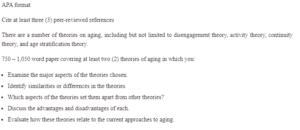Theoretical Perspective On Aging
Examine the major aspects of the theories chosen.
The theory of disengagement and activity is the two theories considered for this task. The idea of disengagement is a thesis that requires that all people undergo the aging process and that, when it happens, people slowly disconnect from society and others. The first theory to handle aging was established by Henry ad Cumming. This means that some interactions with the company and others are inevitably revoked. Due to their specified social duties, this disengagement varies across persons of different genders. For example, men are viewed as winners of bread, while women have a socio-emotional function. In theory, people expect to die sometimes and, therefore, decrease or deteriorate their talents as time passes, finally losing their closer links with others or with society (Bengtson, 2009).
The theory of aging activities is a belief that proper aging is accompanied by the coherence of levels of training and maintaining social activity and contacts. This means they should be active and maintain social relationships with people even when they are elderly. As authored by Robert Havighurst, this thesis directly opposes the view of the retirement theory that older people reject all forms of activity and social relationships (Powell, 2006).
Identify similarities or differences in the Theories.
These two ideas are also comparable as they were the first theories on aging with the view of disengagement (1961) and activity theory (1964). The two approaches are divided into three fundamental aging theories, combined with continuity (Bengtson, 2009). Both these hypotheses may explain the psycho-social aspects linked with aging in older people; hence, the only elements defining aging are activity and retirement. The critical distinction between these two theories is that they are detached, as people age, from the theory of disengagement of social roles and relationships. The alternative (activity hypothesis) explains that when you grow older, you must remain active and have social connections until you age. Thus, the recommended manner of maintaining self-conception among older persons is significantly different. Activity theory considers old age as only a broader middle-aged variant. On the other hand, it is seen as a distinctive phase of life from all different stages—disengagement theory.
Determine which aspects of the theories set them apart from other theories.
These two theories differ because they focus on the main aspects of activity level and social withdrawal. The other theories primarily focus on the body, such as the neuroendocrine theory, which focuses on the wear and tear experienced by the human endocrine system. This free radical theory focuses on the radicals of the human body and the molecules in the body. The membrane theory and the mitochondrial theory also focus on the human body aspects (membranes and strength of mitochondria, respectively).
Include the advantages and disadvantages of each.
The advantage of the disengagement principle is that it enables older people to rest, releases tasks and responsibilities, and offers a way to take up the younger generation. Thus, it supports transferring functions from the era to ensure stronger young ones face demanding jobs. The notion of activity offers the advantage of encouraging older people to remain active. This stimulates them and allows them to lead a better life or improve their health. Each is suitable for staying involved in social activities, housework, gardening, etc. The downside of the disengagement principle is that older people also have to do physical activities to remain healthy and fit (Powell, 2006). Advocating the whole transfer of duties may not be the most excellent option for an older adult. It is also an early school approach that cannot be used in modern society because of the high living costs that aging can entail to earn a livelihood. The theory of activity can also lead to a conflict of power generation. There may be a sense that they stick to power and won’t give the following generation roles.
Evaluate the present approaches to aging in how these ideas interact.
Modern aging theories were classified into ideas of mistake and programmed theories. Programmed theories explain that when the biological clock ticks, aging takes place, and this is unavoidable. Error theories suggest that aging is caused harm to human bodily systems, and its fault lies with the environment. This happens as well over time. The theories of disengagement and activity are consequently more related to programmatic approaches as they both realize that the body becomes weaker over time and does not operate as previously (Powell, 2006).
References
Bengtson, V. L. (2009). Handbook of theories of aging. New York: Springer.
Powell, J. L. (2006). Social theory and aging. Lanham, Md: Rowman & Littlefield Publishers.
ORDER A PLAGIARISM-FREE PAPER HERE
We’ll write everything from scratch
Question
APA format
Cite at least three (3) peer-reviewed references

Theoretical Perspective On Aging
There are a number of theories on aging, including but not limited to disengagement theory, activity theory, continuity theory, and age stratification theory.
750 – 1,050 word paper covering at least two (2) theories of aging in which you:
- Examine the major aspects of the theories chosen.
- Identify similarities or differences in the theories.
- Which aspects of the theories set them apart from other theories?
- Discuss the advantages and disadvantages of each.
- Evaluate how these theories relate to the current approaches to aging.

